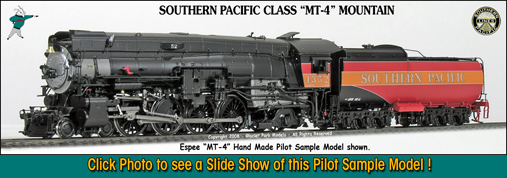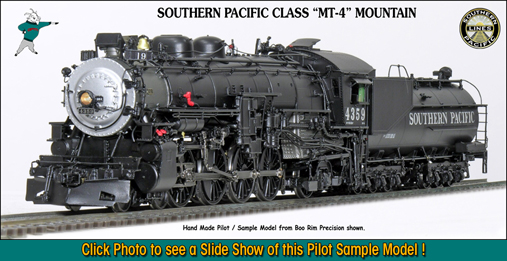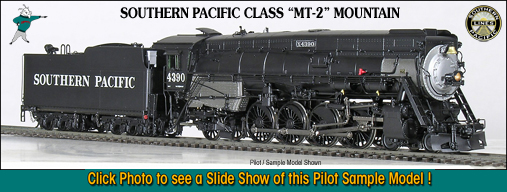

|
The #4390 in this great photo was one of the only 6 locomotives populating the Espee's Class "MT-2". She was also one of the oldest of the MT's, being constructed by for the El Paso & South Western the American Locomotive Company's (ALCO ) "Brooks" shops in 1924. But also in 1924. the S.P. purchased the EP&SW and the MT-2's came along with the deal. ( Scroll down for more info.) This locomotive, with its "Skyline Casing" had never been modeled before. In fact, many of the "MT-1" through "MT-5" class locomotives we produced in miniature had never been modeled before. |

The general design and specifications for these remarkable Espee engines were worked up under the direction of the Espee's George McCormick and Frank E. Russell, Assistant Mechanical Engineer. Ten engines were contracted out to the American Locomotive Company (ALCO) early in 1923, to be delivered later that year. ( A staggering feat, by any mans standards ! ) Final details were worked out at Schenectady between the ALCO's engineers and top men from the S.P.'s mechanical department. In later years these locomotives could be found literally all over the system where fast motive power was required. Fast freights, Commuter Service, even Helper Service on notorious mountain passes such as Donner and Tehachapi. GLACIER PARK MODELS produced the MT-4 and MT-5 Class Mountains in no less than 13 different guises ! ** Each version a carefully researched and accurately scaled replica of the real thing ! ** ( No, we didn't just produce one version and letter it with 13 different number jingles. The prototype didn't do that, and neither will we ! ) To help our fans in their decision making, we invited them to peruse the prototype photos seen below. |
 Engine Number 4300 shown with "Skyline Casing" atop her boiler, ( Applied in
1941 ) and the 120 C-3 she carried throughout
her 34 years of service.
Engine Number 4300 shown with "Skyline Casing" atop her boiler, ( Applied in
1941 ) and the 120 C-3 she carried throughout
her 34 years of service.
|
Engine number 4300 was among the first of the ten MT's built. Constructed for
the Espee by the Alco Locomotive Company's Schenectady shops, these ten
locomotives were delivered to the Espee in El Paso, Texas, and rolled,
deadheaded into Los Angeles in December of 1923.
After a short break in period, they were assigned to head up the "Golden State Limited", a grueling run of some 815 miles of mountains and deserts separating Los Angeles from El Paso. |
|
|
|
Locomotive #4328 was the first of the MT's to be constructed by the Espee's own
Sacramento Shops. ( Those shops must have been something to see, eh? )
She was outshopped on September 30th of 1925. Her "Clamshell" Smoke Deflector apparatus was installed in 1934. And like many of her siblings, she was "Skylined" in 1948. #4328 remained in service until September of 1953. |
 Locomotive #4328 "Alligator Crosshead Guides", 120 C-1 Tender and a "Clamshell"
Smoke Deflector, indicating she was equipped for Mountain District duty.
Locomotive #4328 "Alligator Crosshead Guides", 120 C-1 Tender and a "Clamshell"
Smoke Deflector, indicating she was equipped for Mountain District duty.
|
 Obviously, #4344 was outfitted for Mountain District service, with her
pressed steel pilot and "Clamshell" Smoke Deflector. The huge Worthington
"BL" Feed Water Pump certainly adds character to her, doesn't it?
Obviously, #4344 was outfitted for Mountain District service, with her
pressed steel pilot and "Clamshell" Smoke Deflector. The huge Worthington
"BL" Feed Water Pump certainly adds character to her, doesn't it?
|
Locomotive #4344 is another of the Espee's own creations. She was involved in a
wreck in the early 1940's and lost her pre-wreck skyline casing at that time.
Our pre-1947 model will reflect this appearance.
She was "skylined" once again in 1949, which is how our post-1947 version will appear. For both versions she was followed by the huge, "Semi-Vanderbilt" Class 160 C-1 Tender which you see in this photo. |
|
|
 Locomotive #4352 is one classy lady! Besides her very modern "Laird Multiple
Bearing Crosshead Guides", she boasts a "Scullin Disk" Main Driver, a 160 C-1
Tender and a to-die-for Daylight" Paint Job to boot!
Locomotive #4352 is one classy lady! Besides her very modern "Laird Multiple
Bearing Crosshead Guides", she boasts a "Scullin Disk" Main Driver, a 160 C-1
Tender and a to-die-for Daylight" Paint Job to boot!
|
Locomotive #4353 was #4352's stablemate. Though not always the case, several
iconographer captured them on film, double headed on the Tehachapi and Saugus
grades back when they were in their prime.
But they weren't identical twins, by any means. A quick look at these two photos will reveal that they had different pilots, and crossheads and guides as well. Of course, other subtle differences were there on these models for our friends anc customers to discover for themselves. |
|
Locomotive #4354 was the ninth MT-4 produced by the Sacramento shops. She was
outshopped in October of 1927 and remained in service for almost 30 years,
finally meeting the scrappers torch in June of 1957, making her one of the very
last steam engines to ply the Espee's rails.
Aside from being cosmetically more appealing, the stamped metal cylinder head covers served to insulate cylinder heads from the ice and snow of the mountain districts, adding to their operating efficiency. You will note that her whistle is "up front", probably in an effort to get it as close to the traffic it was designed to warn as possible . |
 One look at #4354's "naked" cylinder heads and you know she must have been a
"Valley" engine. She too carries the huge, "Semi-Vanderbilt" Class 160 C-1
Tender.
One look at #4354's "naked" cylinder heads and you know she must have been a
"Valley" engine. She too carries the huge, "Semi-Vanderbilt" Class 160 C-1
Tender.
|
|
|
|
Locomotive #4368 was the second of the MT-5 class 4-8-2's produced by the
Sacramento shops. She was outshopped in November of 1929, a month after the
infamous stock market crash of 1929. She would remain in service until
December of 1954. Almost 25 years.
Note that she has the multiple bearing crossheads and guides, and has been retrofitted with a Scullin disc main driver. These latter were much stouter than the original spoked drivers, so whenever one of the spoked ones became irreparable, it would inevitably be replaced with one of the newer disc versions. |
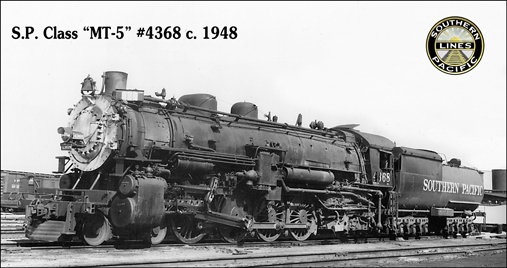
|
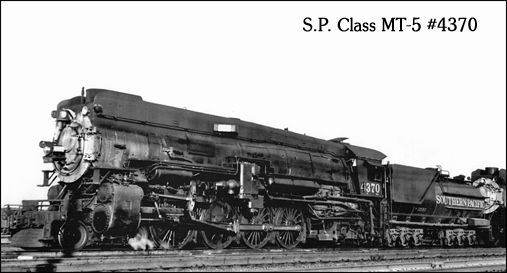 Engine number 4370 has multiple bearing crossheads and guides. Her tender for
this occasion is a class 120 C-5.
Engine number 4370 has multiple bearing crossheads and guides. Her tender for
this occasion is a class 120 C-5.
|
Locomotive #4370 was the ninth MT-4 produced by the Sacramento shops. She was
outshopped in December of 1929 and remained in service for a cool 27 years.
According to Robert Church's book, "The 4300's", in 1936 she'd been assigned to the Salt Lake Division, but by the time this photo was taken she'd been re-assigned to the Western Division. She was probably in commuter service by this time. The 4300's had great acceleration, and could handle the commuter cars with ease. |
|
In this photo, it appears that #4373 is in need of some service. But this photo
was taken late in her life. She'd been relegated to commuter service. Two years
from now and she would be history. ( According to Church's book, she was
scrapped in 1959. )
Worthy of note is #4373 has a large, riveted patch on her smokebox below where the front end throttle enters the smokebox, as did #4352 and #4368. But #4373 also has a very large pipe emanating from ahead of her stack down to behind her cylinder. Strange. Its purpose is unknown to this writer. ( Who, it might be noted, at one time thought he knew everything. Ahem. ) |
 Engine number 4373 has multiple bearing crossheads and guides, and a Scullin
disc driver, naked cylinder heads and pulls a 160 C-1 tender.
Engine number 4373 has multiple bearing crossheads and guides, and a Scullin
disc driver, naked cylinder heads and pulls a 160 C-1 tender.
|
 Engine number 4376 was assigned to the Portland division. She retains her
original, as built, spoke drivers and carries a Class 120-C-8 "Vanderbilt"
Tender.
Engine number 4376 was assigned to the Portland division. She retains her
original, as built, spoke drivers and carries a Class 120-C-8 "Vanderbilt"
Tender.
|
Locomotive #4376 was the final MT-5 produced by the Sacramento shops. She was
outshopped in March of 1930 and remained in service until July of 1957.
This photo proves she was a "working" engine. Notice how dusty appearing her undercarriage is ? Assigned to the Portland Division, she doubtless rolled many a mile over the high desert country of Eastern Oregon that separated Portland and Klamath Falls. |
|
|
|
Originally constructed by ALCO's Brooks Division in 1924 as E.P.&S.W. #413,
#4388 was put into service in November of that year. She was converted from
coal to oil in 1929.
She was something of a "Boomer" inasmuch as the 1936 roster listed her as Being a part of the Rio Grande division, but by 1948 that had changed to the Sacramento division. The EP&SW engines retained their unusual ( for the class ) step arrangement in the front until they were retired. And their Skyline jacketing was unusual too. as can be seen from this photo. |
 Engine number 4388 started out her life as a coal burner on the El Paso &
Southwestern! This 1947 photo saw her in Tucson, Arizona, with Skyline
Jacketing and pulling a 120 C-8 tender.
Engine number 4388 started out her life as a coal burner on the El Paso &
Southwestern! This 1947 photo saw her in Tucson, Arizona, with Skyline
Jacketing and pulling a 120 C-8 tender.
|
|
As always, these "MT" Class locomotives were right up there on our list of personal favorites. After all, if you appreciate high style in your steam locomotives, what's not to like about these ? In our book, they've got it all ! With a level of detailing and operation only dreamed about a few years back, these models have been created in Lifetime Brass to our specifications by South Korea's Premier Builder of Brass Models, Boo-Rim Precision, for the pleasure of the astute Collector of Fine Hand Crafted Brass Models and the Serious "HO" Scale Operator alike ! 

 WARNING: This site features Adult Hobby Products unsuitable for
children under 14 years of age.
WARNING: This site features Adult Hobby Products unsuitable for
children under 14 years of age.
- This Page and its Contents are Copyrighted Material c. 2008 - 2009 Glacier Park Models - All Rights Reserved. |
